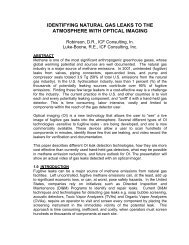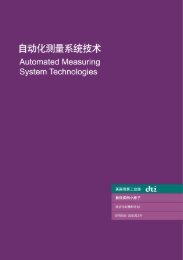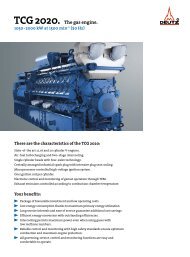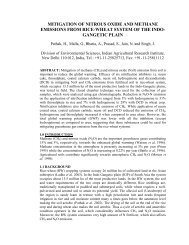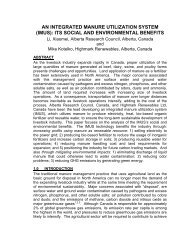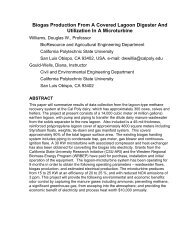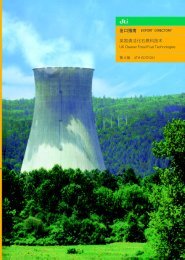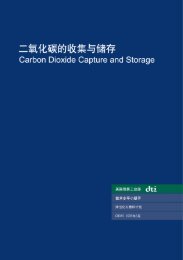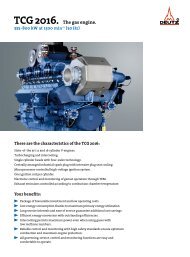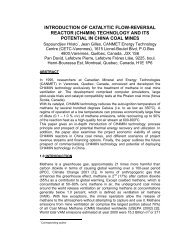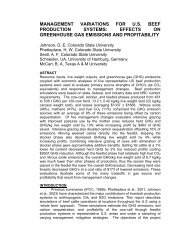reducing the environmental impacts of abandoned coal mines in china
reducing the environmental impacts of abandoned coal mines in china
reducing the environmental impacts of abandoned coal mines in china
You also want an ePaper? Increase the reach of your titles
YUMPU automatically turns print PDFs into web optimized ePapers that Google loves.
Gas leakages from old <strong>m<strong>in</strong>es</strong> can also create serious hazards to <strong>the</strong> public. In<br />
<strong>the</strong> UK, for reasons <strong>of</strong> public safety, passive vents are <strong>of</strong>ten <strong>in</strong>stalled <strong>in</strong><br />
<strong>abandoned</strong> shafts, drifts or surface boreholes drilled <strong>in</strong>to <strong>the</strong> work<strong>in</strong>gs to<br />
provide a low resistance leakage path to <strong>the</strong> surface. Thus, as <strong>the</strong> work<strong>in</strong>gs fill<br />
with water, displaced gases will vent freely to <strong>the</strong> atmosphere. In most cases<br />
<strong>the</strong> gas passively vented represents a small proportion <strong>of</strong> <strong>the</strong> resource<br />
rema<strong>in</strong><strong>in</strong>g <strong>in</strong> a m<strong>in</strong>e. The <strong>environmental</strong> emission is considered to be<br />
acceptable <strong>in</strong> <strong>the</strong> light <strong>of</strong> <strong>the</strong> surface emission risk. Situations have been<br />
observed <strong>in</strong> Ch<strong>in</strong>a where surface emission hazards may be occurr<strong>in</strong>g but<br />
<strong>the</strong>re is no awareness <strong>of</strong> <strong>the</strong> potential problems and no data are available.<br />
2.0 COAL MINE CLOSURES IN CHINA<br />
The <strong>coal</strong> m<strong>in</strong><strong>in</strong>g sector <strong>in</strong> Ch<strong>in</strong>a has undergone substantial re-structur<strong>in</strong>g <strong>in</strong><br />
recent years and this process is ongo<strong>in</strong>g. M<strong>in</strong>e closure is an <strong>in</strong>evitable<br />
consequence <strong>of</strong> chang<strong>in</strong>g from a command and control system to a market<br />
system. M<strong>in</strong>es also have a f<strong>in</strong>ite life due to depletion <strong>of</strong> <strong>coal</strong> reserves.<br />
The government <strong>of</strong> Ch<strong>in</strong>a has implemented m<strong>in</strong>e closure policies to address<br />
two separate issues:<br />
• Clos<strong>in</strong>g and bankrupt<strong>in</strong>g <strong>of</strong> more than 120 SOCMs with depleted<br />
resources and no commercial future<br />
• Clos<strong>in</strong>g <strong>of</strong> Town and Village <strong>coal</strong> <strong>m<strong>in</strong>es</strong> (TVCMs) that fail to meet<br />
safety, licens<strong>in</strong>g and resource access criteria to prevent over<br />
production and price <strong>in</strong>stability. In recent years more than 30,000<br />
TVCMs have been closed.<br />
Gassy SOCMs are potential targets for AMM schemes. Extraction and use <strong>of</strong><br />
AMM from say 50 <strong>m<strong>in</strong>es</strong>, at an average production rate <strong>of</strong> 200l/s pure<br />
(equivalent to approximately 7MW <strong>the</strong>rmal), would produce a mitigation<br />
benefit <strong>of</strong> about 4.4Mt <strong>of</strong> CO 2 equivalent per year.<br />
2.1 IMPLICATIONS OF CHINA’S MINE CLOSURE STRATEGY FOR<br />
GREENHOUSE GAS EMISSIONS<br />
As longwall <strong>m<strong>in</strong>es</strong> tend to emit more methane after closure compared with<br />
room-and-pillar <strong>m<strong>in</strong>es</strong>, Ch<strong>in</strong>a government policy to move to larger longwall<br />
m<strong>in</strong><strong>in</strong>g operations is <strong>the</strong>refore likely to result <strong>in</strong> an <strong>in</strong>crease <strong>in</strong> methane<br />
emissions. Improved gas dra<strong>in</strong>age and utilisation <strong>in</strong> <strong>the</strong> large <strong>m<strong>in</strong>es</strong> dur<strong>in</strong>g<br />
work<strong>in</strong>g could mitigate <strong>the</strong> effect to some extent. Extraction <strong>of</strong> AMM after m<strong>in</strong>e<br />
closure could mitigate emissions fur<strong>the</strong>r.<br />
The total methane emissions from both SOCMs and TVCMs can be estimated<br />
to assess <strong>the</strong> possible impact <strong>of</strong> <strong>the</strong> above changes. First order estimates<br />
shown <strong>in</strong> Table 1, neglect any gas emission reduction due to <strong>in</strong>creased gas<br />
utilisation from 1997 to 2001 and assume an average specific emission <strong>of</strong><br />
1m 3 /t for TVCMs and 10m 3 /t for SOCMs. The table is based on <strong>of</strong>ficial <strong>coal</strong><br />
production statistics, and <strong>the</strong>re is some evidence to suggest that TVCM<br />
production may have been understated. An estimated annual <strong>in</strong>crease <strong>in</strong>



